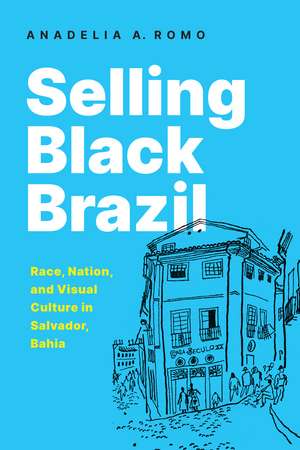Selling Black Brazil: Race, Nation, and Visual Culture in Salvador, Bahia
Autor Anadelia Romoen Limba Engleză Hardback – 18 ian 2022
This book explores visual portrayals of blackness in Brazil to reveal the integral role of visual culture in crafting race and nation across Latin America.
In the early twentieth century, Brazil shifted from a nation intent on whitening its population to one billing itself as a racial democracy. Anadelia Romo shows that this shift centered in Salvador, Bahia, where throughout the 1950s, modernist artists and intellectuals forged critical alliances with Afro-Brazilian religious communities of Candomblé to promote their culture and their city. These efforts combined with a growing promotion of tourism to transform what had been one of the busiest slaving depots in the Americas into a popular tourist enclave celebrated for its rich Afro-Brazilian culture. Vibrant illustrations and texts by the likes of Jorge Amado, Pierre Verger, and others contributed to a distinctive iconography of the city, with Afro-Bahians at its center. But these optimistic visions of inclusion, Romo reveals, concealed deep racial inequalities. Illustrating how these visual archetypes laid the foundation for Salvador’s modern racial landscape, this book unveils the ways ethnic and racial populations have been both included and excluded not only in Brazil but in Latin America as a whole.
Preț: 351.28 lei
Nou
Puncte Express: 527
Preț estimativ în valută:
67.22€ • 73.24$ • 56.64£
67.22€ • 73.24$ • 56.64£
Carte indisponibilă temporar
Doresc să fiu notificat când acest titlu va fi disponibil:
Se trimite...
Preluare comenzi: 021 569.72.76
Specificații
ISBN-13: 9781477324196
ISBN-10: 1477324194
Pagini: 336
Ilustrații: 14 b&w photos, 75 b&w illus., 1 b&w map
Dimensiuni: 152 x 229 x 36 mm
Greutate: 0.65 kg
Editura: University of Texas Press
Colecția University of Texas Press
ISBN-10: 1477324194
Pagini: 336
Ilustrații: 14 b&w photos, 75 b&w illus., 1 b&w map
Dimensiuni: 152 x 229 x 36 mm
Greutate: 0.65 kg
Editura: University of Texas Press
Colecția University of Texas Press
Notă biografică
Anadelia Romo is an associate professor of history at Texas State University. She is the author of Brazil's Living Museum: Race, Reform, and Tradition in Bahia.
Cuprins
Preface
Glossary
Introduction: Race, Identity, and Visual Culture in the Americas
Chapter 1. Precedents and Backdrops: Racial Types and Modern Ports
Chapter 2. Colonial Churches and the Rise of the Quintessential Black City: Modernism, Travel, and the Pathbreaking Guide of Jorge Amado
Chapter 3. Pierre Verger and the Construction of a Black Folk, 1946–1951
Chapter 4. Festive Streets: Carybé and Bahian Modernism
Chapter 5. “Human and Picturesque”: Consolidation in the Bahian Tourist Guides of the 1950s
Chapter 6. All Roads Lead to Black Rome: How the Religion of “Secrets” Became a Tourist Attraction
Epilogue
Acknowledgments
Appendix
Notes
Bibliography
Index
Glossary
Introduction: Race, Identity, and Visual Culture in the Americas
Chapter 1. Precedents and Backdrops: Racial Types and Modern Ports
Chapter 2. Colonial Churches and the Rise of the Quintessential Black City: Modernism, Travel, and the Pathbreaking Guide of Jorge Amado
Chapter 3. Pierre Verger and the Construction of a Black Folk, 1946–1951
Chapter 4. Festive Streets: Carybé and Bahian Modernism
Chapter 5. “Human and Picturesque”: Consolidation in the Bahian Tourist Guides of the 1950s
Chapter 6. All Roads Lead to Black Rome: How the Religion of “Secrets” Became a Tourist Attraction
Epilogue
Acknowledgments
Appendix
Notes
Bibliography
Index
Recenzii
[Selling Black Brazil] is a fundamental critique of the utilization of Blackness in Bahia...The book exposes how tourism, the arts, and elite politicians think about Blackness, and by extension how limited this mode of thinking is. Romo shows how elites can move to capture cultural policies and instrumentalize them according to their interests.
Elegantly written, lavishly illustrated, and cogently argued...Selling Black Brazil challenges historians of twentieth-century Salvador, Brazil’s 'Black Rome,' to think more carefully about how that construction of the city came into being in the 1940s and 1950s and about the limits and exclusions deeply embedded in this portrayal of Blackness as central to Salvador’s culture.
With a compelling and clear prose, Romo’s study is a welcome addition to the literature about Afro-Brazilian art...Reevaluating the relationship of Black identity and Brazilian modernism, [Selling Black Brazil pushes] us to rethink how we teach and study nationalism, race, and art in Brazil.
[Romo] calls attention to the extent to which the story of tourism's visual culture is not only a Brazilian story but an American one, and she makes occasional and evocative references to similar stories elsewhere, such as Peru and Mexico, where tourism imagery helped conflate each nation with its 'native' elements. In Selling Black Brazil, Romo has provided important touchstones for such comparative work. More important, she has deepened our knowledge of both the emergence of Brazilian tourism, which is still, surprisingly, very little studied, and the process of invention that transformed Salvador into Black Rome.
[Romo offers] incisive analysis of print culture, photographs, postcards, and vastly understudied tourism guides written in Portuguese.
Descriere
This book explores visual portrayals of blackness in Brazil to reveal the integral role of visual culture in crafting race and nation across Latin America.
